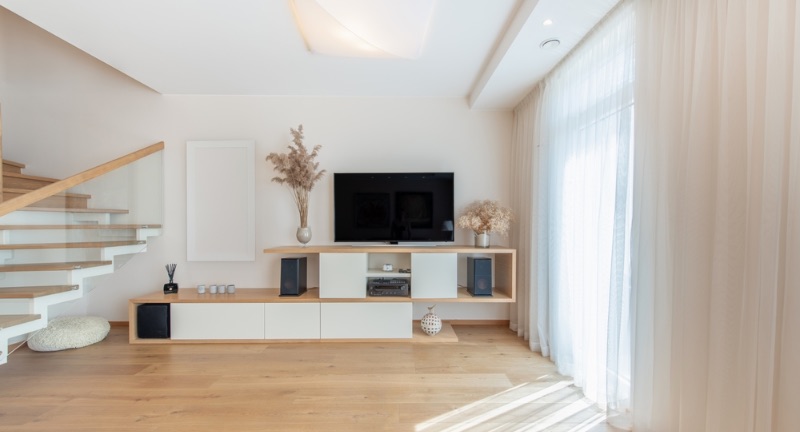HUMAN INTEREST / VIRAL
How to Incorporate Luxury in Your Home Without Breaking the Bank
Published
2 months agoon

Shutterstock
Interior design isn’t just about choosing pretty throw pillows (though we all know that’s important). It’s about creating spaces that work harder for you. The way we design our surroundings directly impacts our mood, efficiency, and even health. Let’s look at why interior design is more important than ever before because, let’s be real, your space should feel as good as that first sip of coffee in the morning. Ready to make your space work as hard as your Wi-Fi signal? Let’s go!
Creates Emotional Impact

Shutterstock
Interior design has the power to shape our emotional responses to a space. A well-designed environment can evoke feelings of calm, joy, or energy, influencing how we experience the world around us. Color schemes, furniture choices, and layout all contribute to creating an atmosphere that impacts our moods. The emotional impact of a space can significantly affect our mental state and productivity, whether at home, work, or in a public place.
Elevates Productivity

Shutterstock
An intelligently designed space has the ability to boost productivity in any setting. Ergonomics, lighting, and the arrangement of furniture are key factors that can make work environments more efficient and comfortable. Well-designed workspaces reduce distractions and promote focus, fostering a more productive atmosphere. The ability to move freely, access tools easily, and work without discomfort can significantly enhance the output of employees or individuals.
Transforms Mood with Color

Shutterstock
Color has an incredible influence on our mood, and interior design uses this fact to create emotional experiences. Soft blues and greens are calming, while vibrant reds and yellows are energizing. The right color palette can subtly alter how you feel when entering a room, creating a sense of tranquility or excitement. Designers carefully choose hues that enhance the purpose of the space, contributing to a more tailored experience.
Reflects Personal Identity

Shutterstock
Interior design allows individuals to showcase their unique personalities through the selection of furniture, artwork, and decor. The way a space is designed can reflect one’s tastes, interests, and style preferences. Whether it’s through minimalist aesthetics, bold colors, or eclectic furniture, the interior tells a story about who lives or works there. Personal identity becomes a tangible part of the environment, making spaces feel more like home.
Encourages Creativity

Shutterstock
Creative spaces inspire innovation and the free flow of ideas. Thoughtfully designed environments, with open layouts and stimulating decor, encourage individuals to think outside the box. Flexible spaces with varying textures, colors, and patterns activate the mind and spark new perspectives. Interior design can create an atmosphere that encourages creative thinking, whether in the office, a studio, or at home.
Maximizes Space Functionality

Shutterstock
The way space is utilized in design can have a major impact on its functionality. Interior design makes the most of available square footage by carefully planning layouts and incorporating multi-functional furniture. It is particularly important in smaller spaces where every inch counts. Whether you’re optimizing storage in a small apartment or creating seamless flow in a large office, effective design maximizes a space’s potential.
Improves Flow and Navigation

Shutterstock
Designing spaces with ease of movement in mind ensures that everyone can navigate a space comfortably. A good layout promotes a natural flow, minimizing the likelihood of congestion or confusion. Thoughtful placement of furniture and clear paths make spaces easier to navigate and more enjoyable to move through. This is especially important in commercial and public spaces where a smooth flow enhances both functionality and user experience.
Sets the Tone for Events

Shutterstock
The atmosphere created by interior design is crucial for setting the tone of any event. Whether it’s an intimate dinner party or a corporate conference, the environment shapes how guests feel and behave. Carefully chosen colors, lighting, and decor contribute to the ambiance, making events more memorable. A well-designed setting communicates purpose, professionalism, or fun, depending on the desired outcome.
Enhances Comfort

Shutterstock
Comfort is one of the most important aspects of interior design, ensuring that a space is both relaxing and welcoming. Ergonomic furniture, temperature control, and appropriate lighting contribute to an overall sense of comfort. A well-designed space provides the right balance between function and coziness, encouraging relaxation and well-being. Whether at home or in a workplace, comfort can reduce stress and increase satisfaction with the space.
Promotes Wellness and Health

Shutterstock
Interior design can significantly impact our physical and mental health by promoting wellness. Thoughtful design incorporates natural elements, such as plants, water features, and natural light, to improve air quality and reduce stress. Additionally, spaces that are designed for movement, relaxation, and sleep can contribute to a healthier lifestyle. A design that promotes health can boost productivity, energy levels, and emotional well-being.
Utilizes Natural Light Effectively

Shutterstock
Natural light has a transformative power in interior design, enhancing both aesthetic appeal and well-being. Maximizing natural light can make a space feel larger, brighter, and more welcoming. It boosts mood, regulates sleep cycles, and even reduces energy costs by cutting down on the need for artificial lighting. Designers strategically place windows, mirrors, and reflective surfaces to harness this powerful resource and bring the outdoors in.
Fosters Social Interaction

Shutterstock
Interior design plays a crucial role in facilitating social interactions within a space. Open floor plans and thoughtfully placed seating arrangements encourage communication and engagement among people. The design of a space can promote collaboration in a workplace or foster connections at a social gathering. By considering flow and comfort, designers create environments that naturally bring people together.
Influences Decision Making

Shutterstock
The design of a space can subtly influence decisions, from purchases in a retail setting to the way we interact with products or people. In stores, colors, product displays, and lighting are strategically chosen to create an atmosphere that guides customer behavior. In the workplace, interior design can inspire employees to make better decisions, fostering focus, clarity, and motivation. Understanding how environment impacts choice is a powerful tool for designers.
Supports Mental Clarity

Shutterstock
A well-designed space can help clear mental clutter, promoting focus and mental clarity. Clean lines, organized storage, and minimal distractions help the mind stay sharp. By reducing visual noise and creating a harmonious environment, interior design enables better concentration and creativity. When a space is organized and calm, it allows us to be more present and productive.
Encourages Sustainable Living

Shutterstock
Sustainable interior design promotes eco-conscious living by using energy-efficient materials and reducing waste. By incorporating green design principles, such as using sustainable materials and maximizing natural light, designers create spaces that are environmentally responsible. Energy-efficient appliances and upcycled furniture also contribute to a more sustainable lifestyle. This approach not only reduces the carbon footprint but also encourages occupants to live more consciously.
Boosts Property Value

Shutterstock
Quality interior design can increase the value of a property, making it more desirable to buyers or renters. A well-executed design that incorporates modern trends and timeless elements can make a lasting impression. Thoughtful space planning, quality materials, and stylish finishes add a sense of luxury and refinement. Whether you’re preparing a home for sale or enhancing a rental property, great design is an investment that pays off.
Improves Acoustic Quality

Shutterstock
Interior design influences the acoustics of a space, shaping the way sound travels and how noise is absorbed. Designers use materials like carpeting, wall coverings, and ceiling panels to control sound levels, creating more pleasant environments. Good acoustics improve focus, communication, and overall comfort, especially in offices, conference rooms, or theaters. In residential spaces, it helps to reduce unwanted noise and create a peaceful retreat.
Sparks Curiosity

Shutterstock
Interior design that is unexpected or unconventional can spark curiosity and engage visitors or residents. By using bold patterns, unusual materials, or unexpected combinations, designers create spaces that make people want to learn more. Interesting design elements can act as conversation starters, leading to deeper exploration of a space. Whether it’s through art installations, hidden details, or innovative layouts, curiosity is an important result of good design.
Affects Perception of Space

Shutterstock
The way a space is designed can alter our perception of its size, shape, and functionality. Strategic use of mirrors, colors, and layouts can make small spaces feel larger or cozy spaces more intimate. The design of a room can either enhance or reduce a person’s perception of its purpose, whether it’s a dining room, living room, or office. Interior designers understand how to manipulate these perceptions to maximize the utility and appeal of any space.
Improves Air Quality

Shutterstock
Indoor air quality is a crucial element of interior design that directly impacts health and well-being. Designers can enhance air quality by selecting materials that are low in toxins and promoting the circulation of fresh air. Incorporating plants, air purifiers, and ensuring good ventilation systems improve the air inside a space. A healthy indoor environment is essential for maintaining mental clarity, reducing allergens, and supporting overall wellness.
Sets a Sense of Luxury

Shutterstock
Luxury in interior design is not just about expensive materials, but about creating a space that feels indulgent and extraordinary. The careful use of high-end textures, finishes, and unique design elements elevate the overall aesthetic. Opulent design can evoke a sense of sophistication and relaxation, offering a retreat from the outside world. By creating an atmosphere of exclusivity and comfort, luxury design enhances the experience of those who inhabit the space.
Brings Balance and Harmony

Shutterstock
Balance and harmony are fundamental principles of good interior design that create a sense of peace and order. Symmetry, proportion, and careful distribution of visual elements prevent a room from feeling chaotic. A harmonious space allows for fluid movement and a comfortable atmosphere, enhancing the emotional experience of those who occupy it. Through thoughtful design, spaces can exude a sense of calm that fosters relaxation and ease.
Fosters a Sense of Community

Shutterstock
Interior design that fosters a sense of community focuses on creating spaces that bring people together. Shared spaces, communal tables, and welcoming layouts encourage interaction and collaboration. Whether it’s in the workplace or at home, these spaces are designed to nurture connections and relationships. A sense of belonging is cultivated through spaces that encourage shared experiences, creating stronger bonds among individuals.
Highlights Architectural Features

Shutterstock
Interior design highlights the architectural features of a space, celebrating its structure and design. Whether it’s a soaring ceiling, exposed brick wall, or grand staircase, interior design ensures these elements stand out and become focal points. Careful lighting, furniture placement, and color choices draw attention to unique architectural features, elevating the overall aesthetic of the space. These elements not only enhance the design but also help tell the story of the building’s history and character.
Stimulates Memory and Learning

Shutterstock
Designing spaces that enhance memory and learning involves creating environments that are conducive to focus and retention. Strategic use of color, layout, and lighting can stimulate the brain and improve concentration. Educational spaces, such as classrooms or study areas, are designed to encourage interaction, focus, and creative thinking. The right design can enhance cognitive functions and provide an environment where learning thrives.
Evokes a Sense of Escape

Shutterstock
Interior design can create spaces that provide a sense of escape, offering a retreat from the hustle and bustle of daily life. Tranquil settings with soft lighting, soothing colors, and comfortable furniture can transform a room into a sanctuary. A carefully designed space can help individuals disconnect from stress and recharge, fostering a sense of relaxation. Whether it’s a cozy bedroom or a peaceful meditation room, interior design can facilitate moments of respite and rejuvenation.
Conclusion

Shutterstock
Interior design is about creating spaces that work for you, boosts your mood, and maybe even sparks some creativity (or at least make your Zoom meetings a little more tolerable). The right design can transform any space from “meh” to magnificent. Whether you’re a minimalist or a maximalist, there’s a design solution for everyone. Now, go forth and make your space as awesome as you are!
Related Topics:

More From Lifestylogy
-


25 Fruits That Have A Sour Reputation And Taste
-


Fabulous Fruit: 30 Of Tomatoes Biggest Historical Accomplishments
-


29 Foods Your Dentist Wishes You Would Stay Away From
-


27 Habits To Implement That Could Change Your Life For…
-


How To Fall Asleep Fast
-


30 Low-Calorie Foods That Satisfy And Help You Feel Full
-


25 Ways To Incorporate More Magnesium Into Your Diet
-


Are Your Friends Acting Differently Around You? Here Are 30…
-


26 Reasons Everyone Should Be A Server A Least Once…